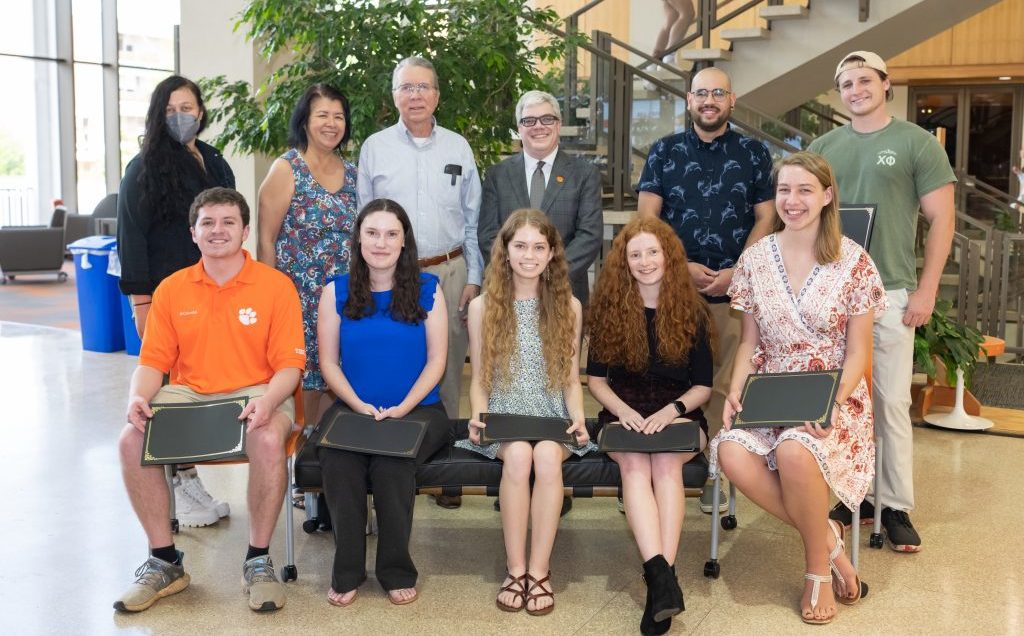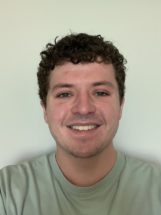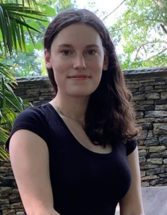
Using resources from Clemson University libraries, four College of Agriculture, Forestry and Life Sciences (CAFLS) students have been recognized for their Creative Inquiry projects in the first Clemson Libraries Undergraduate Student Research Award.
Two wildlife and fisheries biology seniors, Carter Balach and Conor Joye — along with biological sciences student Allison DeLoache — comprised the team that garnered second place for their project, while animal and veterinary sciences students Faith Shupard and Leah Stokes finished third.
The award recognizes students who use library resources and services to produce outstanding research or scholarly or creative works. Both the second- and third-place teams were projects in Creative Inquiry, Clemson’s cross-disciplinary undergraduate research program.
Wildlife and Fisheries Biology students
The second-place project, “Effects of Trout Stocking on Aquatic Insect Abundance in Western North Carolina Streams,” was mentored by Catherine Jachowski, assistant professor in the department of forestry and environmental conservation, with significant assistance from doctoral student Dan Knapp.
“The Creative Inquiry program provides such a unique opportunity for students to not only explore their interests, but also gain valuable experience in designing, performing, and presenting research,” Knapp said.
Aquatic insects are the base of the food web in southern Appalachian streams, and many native fish and amphibians depend on them as a primary food source, Jachowski said. Non-native trout are also heavily stocked in many streams to provide recreational opportunities for the public.
“Allison, Conor and Carter were interested in understanding how releasing large numbers of these non-native predators might influence the abundance of insect prey available to native species, especially hellbender salamanders, which are an endangered species in North Carolina that feed primarily on certain types of insects for the first few years of their life,” Jachowski said.
The team sampled aquatic insect communities in two streams — one heavily stocked with trout and one that harbored a relatively small resident trout population but was not stocked intensively — before stocking events occurred and immediately after. The findings showed the total number of insects was actually higher after stocking than before, and furthers analysis seemed to indicate variability among specific types of insects, meaning some declined and some increased.
Balach, from Mt. Pleasant, South Carolina, said he felt very fortunate to have been awarded the research opportunity.
“It was very hard work but getting out in the field is definitely one of the best experiences I’ve had in my time here at Clemson University,” he said.
Joye, who hails from Port Royal, South Carolina, added: “This project provided me with valuable experience doing intensive scientific research. To see our hard work in the field and the lab pay off has been very rewarding.”
But it wasn’t just a rewarding educational experience. Jachowski said the team’s results would provide novel insight into how trout stocking may influence food availability for native Appalachian stream species and, specifically, hellbenders.
“This team braved some cold water and many long hours in the lab to learn more about Appalachian stream ecology and how non-native fish might influence those systems. They did an awesome job,” Jachowski said.
Animal and Veterinary Sciences students
Shupard and Stokes placed third for their project, “Are Laying Hens a Suitable Translational Research Model for Osteoporosis in Humans?” Shupard is from Bluffton, South Carolina, and Stokes is from Camden, South Carolina. Both are senior animal and veterinary science students studying under the guidance of Jeryl Jones, an animal and veterinary sciences professor and are interested in animal health research, specifically diagnostic imaging. They will be attending Mississippi State College of Veterinary Medicine after graduating from Clemson.
“We spent our first semester familiarizing ourselves with basic poultry anatomy and physiology, emerging areas of emphasis within the poultry industry, and developing an understanding of diagnostic imaging,” Shupard said. “Through this preliminary research we found that avian species are often overlooked as animal models. Mammals are far more commonly utilized. While understandable in many cases due to the evolutionary similarities, we hypothesized that poultry could still fulfill certain criteria for animal models.”
During their research, they found osteoporosis is an important animal welfare issue for the egg production industry.
“Given the natural onset of the disease during a laying hen’s life, as opposed to a state of induced disease, and the shorter generation time for laying hens, we became intrigued with the idea of using laying hens as a model for human osteoporosis,” Stokes said. “We formulated our research question: Are laying hens a suitable translational research model for osteoporosis in humans?”
Their research consisted of finding articles that proposed a set of criteria to define a “suitable translational model” for human osteoporosis. They conducted a literature review to find published articles that show laying hens can fulfill these specific characteristics.
“From our previous semester of research, we were familiar with the range of databases available to us as well as the immense scope of poultry research,” Shupard said.
Preliminary findings look promising. Based on their research, the students said they believe laying hens could be used to model osteoporosis treatments or to study the natural progression of osteoporosis from induction to bone fracture. The exact use of laying hens could vary based on the research being conducted.
“We plan to complete further analyses and submit an abstract with results of these analyses for presentation at the American College of Veterinary Radiology 2022 Scientific Conference,” Shupard said. “If our abstract is accepted, results will be presented in a poster and the abstract will be published in the journal Veterinary Radiology & Ultrasound. We look forward to the next steps of this research process and are excited for what the future holds.”
This experience has been valuable. To ensure they followed best practices for their literature review, the students enlisted the assistance of Maggie Albro, a Clemson science librarian. They used databases and other materials available from Clemson libraries to conduct their research.
In addition to Albro’s assistance, the students said they benefitted from knowledge gained by taking classes, including AVS 3100 and AVS 4060.
AVS 3100 Animal Health provides a broad overview of factors impacting animal health and the common diseases associated with livestock. Guest speakers, such as the state veterinarian and researchers from the Godley Snell Research Center met with the class to explain how animals, especially livestock, can be used for research.
In AVS 4060 Seminars & Topics, students are given an overview on how to gain scientific writing skills. Guest speakers from Clemson Libraries met with the class to explain the importance of predatory journals, how to use RefWorks, and how to utilize Clemson Library resources and databases.
“By participating in this Creative Inquiry project, we have developed research skills such as evaluating strengths and weaknesses in original investigations, identifying predatory journals, and tailoring a search string,” Shupard said.
The Creative Inquiry program is a combination of engaged learning and undergraduate research, unique to Clemson University. While participating in the program, students take on problems that spring from their own curiosity, from a professor’s challenge or from the pressing needs of the world around them. Team-based investigations are led by faculty mentors and typically span 2-4 semesters. Students take ownership of their projects and take the risks necessary to solve problems and get answers.
Creative Inquiry participants develop critical thinking skills, learn to solve problems as a team and hone their communication and presentation skills. Students often find themselves presenting their work at national conferences, fielding questions from professionals. Course credit is given.
-END-
Get in touch and we will connect you with the author or another expert.
Or email us at news@clemson.edu




